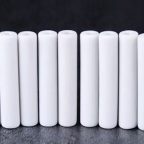EDM mainly produces high-temperature melting and vaporization of materials through discharge between electrodes. Therefore, the machinability of materials mainly depends on the thermal properties of materials, such as melting point, specific heat, thermal conductivity, etc., while the mechanical properties of materials have little influence. . EDM is suitable for the machining of superhard conductive materials. Since most ceramic materials are electrical insulators, electrical discharge machining was rarely used in the past. But in recent years, many high-performance ceramics contain conductive materials such as TiC, which makes EDM possible. (1) Processing of conductive ceramics A considerable part of ceramics has a certain degree of conductivity, so it can be directly processed by EDM. Commonly used machining methods are wire EDM and EDM. Based on wire EDM and forming, other machining methods can also be derived, such as inner and outer EDM and surface grinding, tool sharpening, EDM slot milling, EDM of gears and threads, etc.
Electrical machining of ceramic materials (2) Machining of non-conductive ceramics Non-conductive ceramics do not have electrical conductivity, so they cannot be directly used as electrodes for electrical discharge machining on the other side. In this regard, the electrolytic solution method and the high voltage method are generally used to create the conditions for generating spark discharges, and the non-conductive ceramics are processed. Electrolyte method is actually electrolytic EDM composite machining, which is the most studied method at present. This method usually uses the bubbles generated on the tool electrode during the electrochemical reaction to form the non-conductive phase required for spark discharge in the electrolyte, and the workpiece is eroded by the thermal effect of the bubble discharge, in which electrolysis and chemical effects also play a role significant impact.
However, the gas phase formation speed of the electrolyte method is slow, the discharge breakdown delay time is long, and a large amount of electrolytic energy is consumed, so the machining efficiency is low and the energy consumption is large. In this regard, some people propose to use the airflow adsorption and eddy current effect of the tooth electrode rotating at high speed, or use the technology of controllable inflation to solve the problem. The high-voltage method is to place an insulated workpiece between the tip electrode and the flat electrode, and apply high-frequency high-voltage pulse power to the two poles. Due to the parasitic capacitance between the two poles, part of the insulation near the tip electrode is destroyed, and a glow discharge occurs, so as to achieve high machining efficiency. Purpose. Generally, the voltage used is 5000-6000V, the highest is 12000V, and the frequency is tens of kilohertz to tens of megahertz.
Pintejin Industrial Ceramics Factory is an expert in structural ceramics, with direct sales from structural ceramics manufacturers, with competitive prices; structural ceramics molding/sintering/precision machining processes are mature, delivery time is accurate, and quality is guaranteed.
Pintejin machining ceramic service include : Alumina Ceramic Parts, Zirconia Ceramic, Silicon Carbide Ceramic, CNC Machined Aluminum Nitride Ceramic, Machinable Ceramic Parts, Glass Ceramic,Macor Ceramic,Powder Metallurgy Dies,Ceramic Injection Molding,Ceramic Dry Pressing,Ceramic Extrusion Dies




